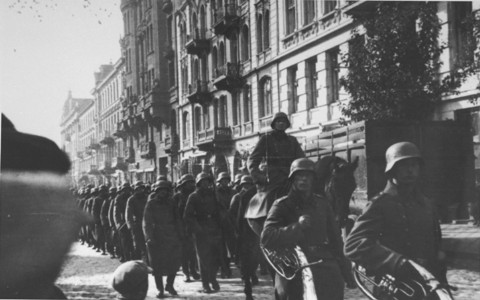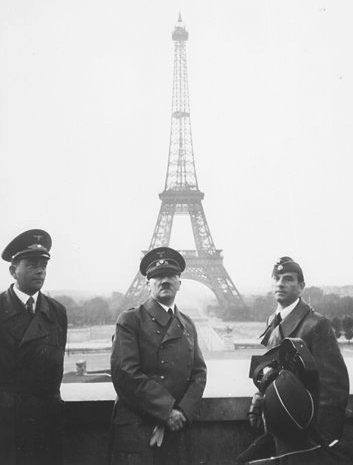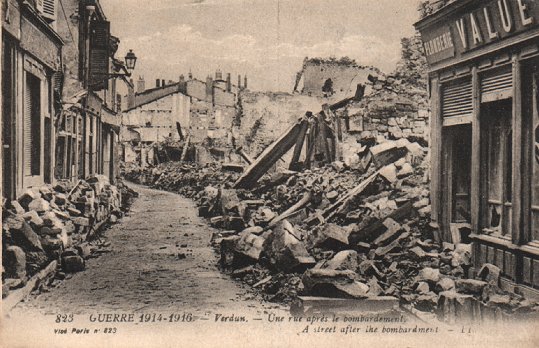It was seventy years ago today that Germany’s “Operation Red” – the invation of France proper – began.
It took fifteen days for Germany to bring France – which a month before had been continental Europe’s greatest military power – to the armistice table. The speed and completeness of the defeat – to say nothing of the potency of the metaphors surrounding the debacle – have combined to make “french defense” a bit of a punchline in America.

Let me be the first to say that in many ways, France got a very, very bad rap.
We’ll get back to that. First, the history.
———-
There isn’t much of it. After the French sent their best troops – including most of their armored divisions – charging into Belgium to the rescue of the Belgians and Dutch, the Germans sent the elite of their military charging through the Ardennes Forest, exactly as they had in 1871 and 1914, and exactly as they would in the winter of 1944 at the Battle of the Bulge.
They crossed the only real obstacle – the Meuse River – at Sedan, bringing the full weight of the blitzkrieg, Stukas and massed tanks, to bear against a French division that broke and ran – eventually, after giving two German Panzer divisions a bloody nose trying to cross the river – not so much out of “cowardice” as being grossly unprepared for what they faced. Indeed, the French division beat back half of the German attempts to cross the river; it was the other half, and the relentless bombing, and the disruption in communication it caused, that sent them eventually running to the rear. More on this below.

After Sedan, it took mere days to drive to the Channel. This cut off the French First Army and the British Expeditionary Force, whose evacuation from Dunkirk finished seventy years ago yesterday.
That left it to the Germans to charge into the French interior and finish the game. After their ghastly losses in the North – including all of their five armored divisions and much of the best of the French Air force – the French had 63 remaining divisions (plus one British division that’d stayed in the south) to hold a front that needed sixty of them. The Germans destroyed the French Air Force in short order; the demoralized French gave way across the entire front; by June 14 – in eight days – Paris fell.

Prime Minister Reynaud resigned rather than surrender; the French brought back eightysomething Field Marshal Petain, the great hero of the French resistance at Verdun in 1916, with the intention of signing an armistice.

And on June 22, at Compiegne, in the very railroad car and on the very spot where Germany had signed the armistice ending World War II, the French surrendered.

It was one of history’s great anticlimaxes. Such an anticlimax that it’s been a punchline for seventy years now. The French are forever tarred as “cheese-eating surrender monkeys”.
It’s a bum rap in many ways.
———-
Myth 1: The French were Cowards: How many of you remember the 1970’s?
Our president had just resigned in disgrace.
Our economy was in the tank.
Worst of all, we’d lost the Vietnam War. 56,000 Americans had died for…what? What had we gained, the question went, after that wrenching ordeal?
Between those three causes, America fell into a deep, self-questioning malaise. Some wondered if our greatest days weren’t behind us. Some looked at the “second world” we faced – communism – and wondered if they might not have a good point, and noted that they were at the very least here to stay.
Now, imagine what would have happened if the Soviets had (somehow – I mean, we have to suspend a bit of disbelief here) invaded Canada in about 1978. And our Pentagon plan for an invasion of Canada called for the US to send its best troops – the Airborne, the Marines, the Second Armored, the Eleventh Cavalry, all of ’em – charging north of the border to rescue the Canadians.
Say, then, that the Soviets had landed a huge invasion force at Seattle by complete surprise, and put their tanks on I94 and drove across the demoralized USA, sacking Chicago and driving along the south shore of the Great Lakes and down the Saint Lawrence all the way to theAtlantic, completely cutting off all those troops in Canada from food and fuel and ammunition and leaving America defended by the post-Vietnam National Guard?
It might have gone badly for us.
Now, picture a situation – a national demoralization, a malaise – 100 times worse than that.
Americans have a hard time comprehending being slaughtered en masse. In recent memory, World War II is as close as we got – and the history that we’re told doesn’t record a lot of cases of Americans dying in droves like cannon-fodder. The Civil War, of course. Maybe a few debacles since then – the Volturno and Rapido rivers, the Huertgen Forest, the daylight bombing campaign of 1942 and 1943, places where Americans were killed in huge numbers for no real appreciable gain. Our casualties were light-ish, compared to the Soviet Union (which lost over 10 million soldiers, and at least twice as many civilians, perhaps as many as half of them at Soviet hands); our nearly 400,000 dead of all causes (from combat to ruptured appendixes amounted to 6-8% of those who served.
So if you remember the national garment-rending that accompanied the 56,000 dead in Vietnam – about one in 40 of the soldiers that served there – then wrap your head around this: in World War I, France lost 1.3 million dead and over 4 million wounded – out of a total of 8 million soldiers serving. Nearly two out of three French soldiers were killed, wounded, captured or went missing in four years of war.

This crushed the generation of French that came of age before and during the war years. And it was this generation that went on to become the nation’s middle-management, its field-grade officers, and its low-level politicians by 1940, as well as its family people.

Although not so much of that family thing. While Americans after World War II came home victorious and spawned a baby boom, French soldiers – those that lived – came home and wondered what it was all about. There was a huge baby bust in France in the twenties. French society got commensurately older. And between the destruction of much of the generation that came to middle age by the time of the war and the ravages of the Great Depression, France was beset by a malaise that made the US in the 1970’s look like an evening at Mardi Gras, as well as a relative shortage of military-age males.

As a result, France developed on the one hand a strong desire never to have it happen again. Although there were nearly twice as many Germans as French, France mobilized fully a third of all males between ages 18 and 45, and managed to outnumber the German Wehrmacht. They invested heavily in technology to help make that force more effective – albeit the wrong technology, in hindsight. More below.
But the nation was also a bit like a dog that’d been kicked too hard as a puppy. It was deeply unwilling to go through another national bloodletting. Politics in France was intensely divisive in the twenties and thirties, with parties of the far right and far left battling it out in a way that makes America’s current debate look downright dignifed.
Myth 2: “The Maginot Line Mentality”: The Maginot line was a line of fortresses guarding France’s border with Germany, from the Swiss to the Belgian borders. It’s often bandied about as an example of short-sightedness and strategic hide-boundness; the American left is fond of comparing weapons development projects as having “Maginot Line Mentality” – being expensive and yet uselessly behind the times, or havnig sapped money away from the weapons that, in hindsight, could have turned the Germans back.
All of which makes sense – if you ignore contemporary French history.
The slaughter of World War I made a deep impression on the French psyche – and the casualties made a huge impression on the manpower available to the French military. During the Great War, the French had suffered ghastly casualties in part due to their doctrine of “toujours l’attacque“, “always attack”. Two years of reckless charges into the face of German artillery and machine guns forced a change in plan; the French became much more methodical, relying on heavy reinforced strongholds on defense, and tightly-coordinated attacks with artillery and tanks and infantry moving very deliberately under cover.
This philosophy carried forward as France armed itself for the next round of wars, in the ’20s and ’30s. France created in effect two armies; one intended to be fast, mechanized and armored, manned by the traditional Army – professional soldiers and lots of enlistees in their teens and twenties, intended to fight a combined-arms mobile war; the other with hundreds of thousands of middle-aged reservists in their thirties and forties intented to hold long stretches of the line with as little cost as possible.
And it was for that second army that the Maginot Line was built. A long, complex chain of concrete forts and gun turrets and millions and millions of antitank obstacles and thousands of bunkers and pillboxes connected by tunnels, underground phone lines and even narrow-gauge railways, the Maginot Line was intended to make it easy for a relatively small number of middle-aged weekend warriors to hold off the German army while the first Army worked on the war-winning attack.

And it worked. The Germans had to batter their way through Belgium and the Netherlands to outflank the Line; the younger troops and tanks, the elite of the Army, got cut off and surrendered in Belgium, and only that allowed Germany to move unmolested into the heart of France without having to punch its bloody way through the Maginot Line.
Myth 3: The French weren’t ready for modern war: With their fortresses and their harkening back to the tactics of World War I’s trenches, it looks to someone looking back seventy years that France was anachronistic.
At the time, it was not true. Indeed, in some respects France’s eagerness to modernize was its undoing.
If you work in Information Technology, you know this scenario: when adopting new technology, companies have a choice: Adopt the technology early, and by committing immense financial resources to the change risk having it go obsolete before too terribly long (all of you with companies still running NT4.0 servers, show of hands?), or adopt late and have a buggy, unreliable system.
France took the former route; they standardized their Army and Air Force on technology from the late twenties and early thirties, and built it in huge numbers. And it showed; many of France’s tanks have a distinctly twenties look to them;

- Knocked out French “Char B” tank
many of their fighter planes, built in the mid-thirties in the middle of a period of dizzyingly rapid aircraft development, were sixty miles per hour slower than their British and German counterparts (and the Brits, for their part, almost standardized too late; the Spitfire fighters that carried them through the war almost didn’t make it into service in time to fight).

But they had more tanks, and with the Brits more planes, than the Germans – and the late attempt to rectify the technology was starting to pay off; the French “Somua” tank was possibly the best in the world; the Dewoitine 520 fighter was among the best, although just coming into production.
At any rate – conventional wisdom, when it comes to history, fares about as well as it does anywhere else.
Leave a Reply
You must be logged in to post a comment.